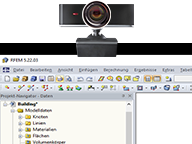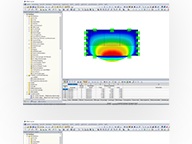Stress Analysis of Surfaces and Members
RF-/STEEL | Features
- General stress analysis
- Automatic import of internal forces from RFEM/RSTAB
- Complete graphical and numerical results of stresses and stress ratios integrated in RFEM/RSTAB
- Wide range of customization options for graphical output
- Flexible design in multiple design cases
- Clearly arranged result tables for a quick overview after the design
- High productivity due to the minimal amount of input data required
- Flexibility due to detailed setting options for basis and extent of calculations
Features of RF-/STEEL Members
- Cross-section optimization
- Transfer of optimized sections to RFEM/RSTAB
- Design of any thin-walled cross-section from SHAPE-THIN: SHAPE-THIN – Cross-Section Properties of Thin-Walled Cross-Sections
- Representation of a stress diagram on a section
- Determination of normal, shear, and equivalent stresses
- Stress results of individual internal forces types
- Detailed representation of stresses in all stress points
- Determination of the largest Δσ for each stress point (for example, for fatigue design)
- Colored display of stresses and design ratios for a quick overview of the critical or oversized zones
- Parts lists and quantity surveying
Features of RF-STEEL Surfaces (Available in RFEM Only)
- Determination of principal and basic stresses, membrane and shear stresses, as well as equivalent stresses and equivalent membrane stresses
- Stress analysis for structural surfaces including simple or complex shapes
- Equivalent stresses calculated according to different approaches:
- Shape modification hypothesis (von Mises)
- Shear stress hypothesis (Tresca)
- Normal stress hypothesis (Rankine)
- Principal strain hypothesis (Bach)
- Optional optimization of surface thicknesses and data transfer to RFEM
- Serviceability limit state design by checking surface displacements
- Detailed results of individual stress components and ratios in tables and graphics
- Filter function for surfaces, lines, and nodes in tables
- Transversal shear stresses according to Mindlin, Kirchhoff, or user-defined specifications
- Parts list of designed surfaces
RF-/STEEL | Input
In order to facilitate the data input, surfaces, members, sets of members, materials, surface thicknesses, and cross-sections are preset. It is possible to select the elements graphically using the [Select] function. The program provides access to the global material and cross-section libraries.
Load cases, load combinations, and result combinations can be combined in various design cases.
The combination of surface and member elements and separate designs allows you to model and analyze only critical parts, such as frame joints, using surface elements. The other parts of the model can be designed using member analyses.
RF-/STEEL | Results
After the calculation, the maximum stresses and stress ratios are displayed sorted by sections, members/surfaces, member sets, or x-locations. In addition to the tabular result values, the corresponding cross-section graphic with stress points, stress diagram, and values is displayed as well. The design ratio can be related to any kind of stress type. The current location is highlighted in the RFEM/RSTAB model.
In addition to the result evaluation in the module, it is possible to represent the stresses and stress ratios graphically in the RFEM/RSTAB work window. It is possible to individually adjust the colors and values.
Result diagrams of a member or set of members facilitate targeted evaluation. Furthermore, you can open the respective dialog box of each design location to check the design-relevant section properties and stress components of any stress point. It is possible to print the corresponding graphic, including all design details.
Webshop
Customize your individual program package and find out all the prices online!
Calculate Your Price

The price is valid for United States.











.png?mw=192&hash=f63e4a3f1836233005de32f60201d5392e507cf1)



